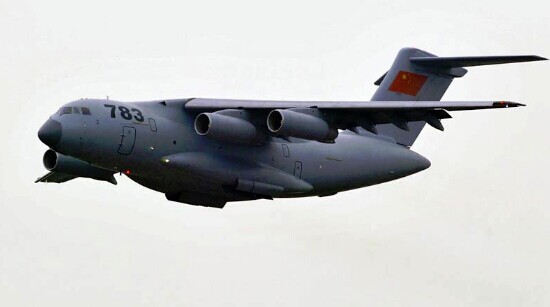

AVIC's Y-20 Kunpeng, a four-turbofan strategic airlifter, could become one of the Chinese company's main exports in years to come. LIANG XU/XINHUA
Accessible option
Sun, the chief designer, told Xinhua News Agency that he hoped the PLA air force will pair the plane with other advanced fighter jets, and that the upgraded J-31 will become China's next-generation aircraft-carrier-borne fighter jet.
Xu Yongling, a military aviation expert and former test pilot, said advanced combat aircraft made by Western countries are usually subject to strict technological and export controls, and as a result, they are very expensive. That makes Chinese-made jets, which will have superior capabilities and cost less, a good choice for developing nations.
Although some observers have said the jet's design means it will be of limited use to the Chinese military, Cao Weidong, a researcher at the PLA Naval Military Studies Research Institute, said the aircraft could still stand a chance of serving as a carrier-borne fighter if the wings, landing gear, and engines were upgraded.
"Although the J-31 has a short flight range, its cutting-edge radar, avionics, and stealth technology will make it a suitable companion for the J-15. It would do a good job of staging first strikes."
Yin Zhuo, a senior expert with the PLA navy, said that buying armaments from China offers developing nations an added bonus-a willingness to help them build their own defense industries.
"China doesn't intend to just earn money from developing countries. We have sold them weapons and equipment, and taught them how to maintain those arms, and if they had the necessary capability, we were also willing to sell them an entire manufacturing facility."
He said China has helped nations such as Pakistan and Indonesia to assemble Chinese weapons, which has enabled them to gradually acquire the ability to develop and produce their own armaments, and eventually establish relatively independent defense industries.
Xu Bangnian, a professor at the PLA Air Force Command Institute, said: "Even if the PLA air force and navy currently don't need the J-31, the plane will still be very popular in the international military aircraft market because it's really the only choice for affordable stealth aircraft."
A heavyweight newcomer
A monster transporter plane was unveiled at the China International Aviation and Aerospace Exhibition. The Y-20 Kunpeng, a four-turbofan strategic airlifter made by the Aviation Industry Corp of China, is set to go on the market, although the People's Liberation Army will be supplied before other customers.
Geng Ruguang, deputy general manager at AVIC, said that development work and tests on the Y-20 have been satisfactory, and added that the huge transporter plane will be available to customers soon. However, Geng declined to say if the company has received any orders from foreign buyers.
Tang Jun, chairman of Xi'an Aircraft Industry, the AVIC subsidiary that's developing the Y-20, was more forthright. "We will develop a number of variations of the Y-20, and we are definitely going to export them," he said. "But the final decision will be up to the related governments and military authorities."
The plane made its maiden flight in January 2013, making China the third nation, after the United States and Russia, to develop a heavy-lift transporter such as the Y-20.
A PLA National Defense University study in July showed that the Chinese military needs at least 10 transport regiments and as many as 400 Y-20s to conduct operations in Asia.
The Y-20 has a maximum payload of 66 metric tons, and a maximum takeoff weight of more than 200 tons, according to military sources
A technical evaluation by Aerospace Knowledge showed that when fully laden with fuel and carrying a payload of 51 tons, the Y-20 can fly as far as 5,200 km, meaning the plane is capable of reaching every part of Eurasia, the US state of Alaska, Australia, and North Africa.
Wang Ya'nan, the magazine's deputy editor-in-chief, said many countries need large transporter planes, because aircraft of this type provide a strategic advantage in power projection.
"In a large-scale deployment, they would have to either make one trip with four small or medium-sized transporters, or have one transporter fly four times to ferry the same amount that can be carried by a heavy-duty airlifter in just one flight. Large transporters such as the Y-20 can enable a rapid and convenient way of projecting power."
A number of geopolitical factors are also likely to help the Y-20.
"The US has sold its Boeing C-17 to India, so it's unlikely to give it to Pakistan," Wang said. "Frankly speaking, nations like Pakistan and some countries in South America can only look to China if they want strategic transporters."
Wu Jian, a military observer in Shanghai, echoed Wang's remarks, saying that Russia hopes its Ilyushin Il-476 will capture half of the market for transporters, but its outmoded design means it's unable to carry certain types of modern weapons.
"The Il-476's cargo cabin design was based on the size of weapons made in the 1960s and '70s, while today's equipment is much larger," he said, noting that the newly developed Y-20 can carry all types of modern equipment.
AVIC sets to launch new airlines in Cambodia
2014-08-21Joy Air, AVIC agree on purchase of 60 planes
2014-08-03AVIC to work with Safran in raising global presence
2014-07-24AVIC draws up plan for UK solar plants
2014-04-30AVIC unveils plan for next-generation regional aircraft
2013-12-20AVIC unit buys German aircraft engine builder
2013-07-25AVIC seeks more co-op at Paris Air Show
2013-06-18Copyright ©1999-2018
Chinanews.com. All rights reserved.
Reproduction in whole or in part without permission is prohibited.